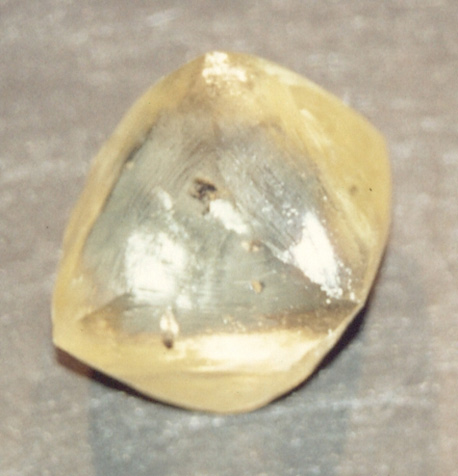
Credit: Eurico Zimbres, FGEL/UERJ via Wikimedia Commons (CC BY-SA 2.0 br [http://creativecommons.org/licenses/by-sa/2.0/br/deed.en]).
If you look inside a diamond, you may find something even more valuable than its spectacular brilliance.
Diamonds form deep within Earth’s mantle, of pure carbon. Their atomic bonds are so strong that they’re Earth’s hardest mineral and our best conductor of heat.
These properties make diamonds valuable for industrial purposes—like on drill bits or rock saws, or in electronics for extreme environments. But that’s not the big surprise.
A diamond’s pure carbon structure makes it very clear. But sometimes trace amounts of boron or nitrogen, the elements on either side of carbon on the periodic table, will sneak in.
Boron turns a diamond blue, like the famous Hope Diamond. Nitrogen turns it yellow. Normally, this would make a diamond less desirable.
But it’s nitrogen that could make diamonds more valuable than ever.
Scientists at the City College of New York have figured out how to activate the nitrogen with red and green lasers, allowing them to store and erase data in three dimensions along the diamond’s crystal structure, at the atomic level. Think about that.
The technology is in its early stages, but researchers believe a diamond the size of a grain of rice could store the entire Library of Congress—five hundred times.
Think about that.
In the future, diamonds could open the possibility for tiny computers or medical devices to bring a shine to our lives that we can only imagine.
Background
Synopsis: Diamonds, the hardest mineral, are highly coveted for their brilliance and fire when cut into gems by expert gemologists to capture the prismatic colors within the stone. They can also be colored by a few atomic replacements or crystal lattice defects. Some of these replacements, when activated by lasers, may provide data-storage capacity far beyond any of our existing technologies.
- Diamonds are typically clear and have very strong atomic bonds that prevent impurities from entering their pure carbon-crystal structure. This remarkable stability makes them the hardest and most thermally conductive of any natural material.
- Diamonds have very high optical dispersion that causes the light entering a diamond to be broken into all the colors of the rainbow. Gemologists facet diamonds by precisely cleaving and polishing them along prescribed planes in the atomic structure in order to trap the prisms of color within the mirror faces in the lower “pavilion” of the gem and focus them out through the flat “table” at the top of the gem into the viewer’s eye.
- Carbon lies between boron and nitrogen on the periodic table; sometimes, tiny quantities of boron can sneak into the crystal to make diamonds blue, like the famous Hope Diamond.
- More often, nitrogen is included and causes the diamond to transmit yellow light ranging from 50 to 1,000 parts per million. Nitrogen-free diamonds are pretty rare.
- Other colors of diamonds occur because of rare crystal imperfections that cause the stones to absorb certain wavelengths of light and transmit the remaining color.
- Lower-quality diamonds, called industrial diamonds, are generally used for cutting and electronics.
- Scientists at the City University of New York have figured out how to store and erase data in three dimensions along the diamond’s crystal planes at the atomic scale by zapping the nitrogen in yellow diamonds with green and red lasers.
- A technology like this would greatly surpass the storage capacities of existing technologies.

